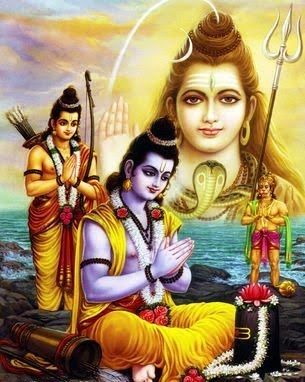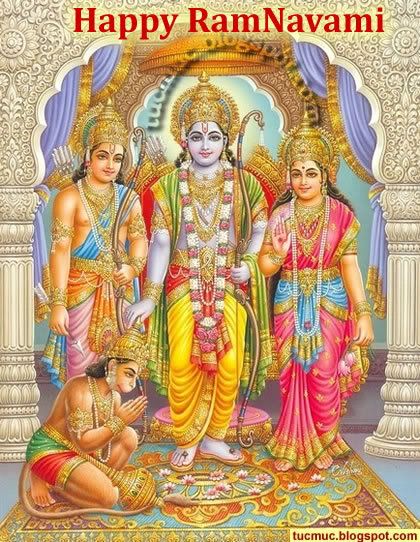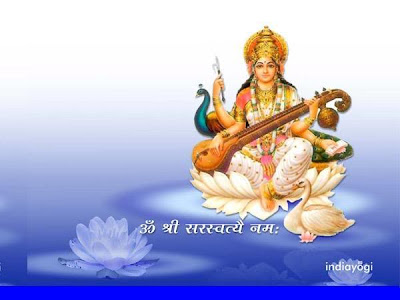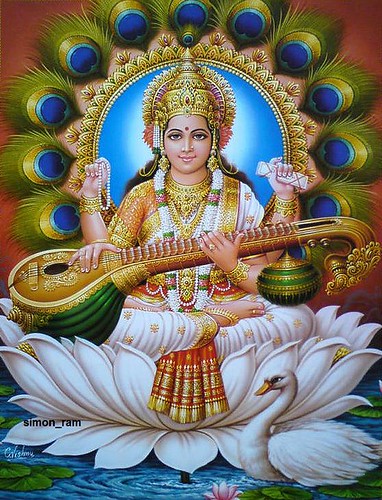VAASTHU SASTRA
Wednesday, July 31, 2013
Sunday, April 1, 2012
SREE RAMA NAVAMI!!!!
Friday, January 27, 2012
VASANTHA PANCHAMI!!!!
Vasant/Basant Panchami Saraswati puja and festival is of great significance in Hindu religion. The festival of Vasant Panchami is celebrated on fifth day of Shukla Paksha of Magh Mas. As per Hindu lunar calendar the month in which full moon day coincides with Maga (Maghah) star, that month is denoted as Maagha masam which occur during the calendar months of January-February. Maagham is a Sanskrit word Ma+Agham. Ma means not present and Agham means sin, evil, malefic, annoyance, suffering, grief and Maagha masam is the month which is highly meritorious, auspicious and free from any sin or suffering. Hence this month is considered as an auspicious month for performing marriages, Gruha Pravesam, Aksharabhyasam etc.
In this year; the festival Vasant/Basant Panchami is on 28th January 2012. It is considered as the birthday of Sarswathi Devi. Saraswathi puja is also observed by several other communities in India on the same day. An important event on the day is the initiation of children into the world of letters on this day.
SIGNIFANCE OF THE FORM OF SARASWATHI:-
Mother Sarswathi who is the bestower of light of knowledge and wisdom. Mother Saraswathi destroys the veil of darkness and brings light to the devotee in the form of wisdom. Sarswathi is the Sakthi, the power and the consort of Brahma the creator. Goddess Sarswathi is the goddess of knowledge and arts, represents the free flow of wisdom and consciousness. It is believed that goddess Sarswathi endows human beings with the powers of speech, wisdom and learning. She is dressed in white which represents purity and her rejection of everything that is base and materialistic. She holds sacred scriptures in one hand and a lotus (symbol of true knowledge) in the second. With her other two hands she plays the music of love and life on a stringed instrument called the veena. Her white swan represents the discrimination between the evil and the good, the eternal and the transitory. The four arms of the goddess suggest the four aspects of human personality i.e. mind, intellect, vigilance, and ego. The pearl string represents the power of spirituality. The goddess Saraswati, sitting on a lotus, symbolizes her wisdom. She is also well-versed in the experience of truth. When the goddess is seen sitting on a peacock, it is a reminder that a strong ego can be held back by wisdom. Goddess Sarswathi suggests that one should be wise regarding the eternal truth.
Victory over the mind is gained only through knowledge and through understanding. Saraswathi represents this highest knowledge of the Self.She removes the ignorance and darkness and grants us the higher knowledge of self. She is the goddess of the spiritual knowledge and the knowledge that frees us from this bind of this materialistic world. Mother Saraswathi is the (Gnaana Shakti) this is the power of knowledge. Mother Saraswathi represents the Sattwic qualities (Love, bliss and peace) once the devotee has rid him/her self of the Rajastic and Tamastic qualities. Mother Saraswathi herself appears as the Sattwic quality and imparts the wisdom needed to attain salvation.
Spiritual Significance of vasant panchami:
Goddess Saraswati is portrayed as the Goddess of Knowledge according to Hinduism. She is the one who bestows the knowledge required for spiritual enlightenment. With Her grace, the mute, it is believed, have been able to speak and people have been blessed with the ability to write or compose poems. As 'Diwali' – the festival of light is to Lakshmi, goddess of wealth and prosperity, and 'Navaratri' is to Durga, goddess of power and valor, Vasant Panchami is to Saraswati, the goddess of knowledge and arts.
Vasant/Basant Panchami festival is of great significance in Hindu religion. It is celebrated every year on the 5th day or ‘Panchami’ of the bright fortnight of the lunar month of Magha, which falls during January-February. ‘Vasant’ comes from the word ‘spring’ as this festival heralds the beginning of the spring season.It is believed that on this day goddess Saraswati was born. Hindus celebrate Vasant Panchami with great fervor in temples, homes and even schools and colleges. It is observed by several other communities in North India on the same day. An important event on the day is the initiation of children into the world of letters on this day. In several parts of India Saraswati Puja is also observed during Navaratri (October – November). During Vasant Panchami, the advent of spring is felt in the air as the season undergoes change. New leaves and blossoms appear in the trees with the promise of new life and hope.
The most significant aspect of Vasant Panchami is that it is also the most auspicious day to begin laying one’s foundations of education – of how to read and write. Musicians sing here and many even choose to perform here first. Instrumentalists have puja performed for their instruments here apart from art and culture. Pre-school children are given their first lesson in reading and writing on this day. Some people do the Saraswati puja on Dussera day. That includes all forms of Saraswati (knowledge), like books, musical instruments, sports, weapons and so on. All Hindu educational institutions conduct special prayer for Saraswati on this day. It is also a great day to inaugurate training institutes and new schools – a trend made famous by the renowned Indian educationist Pandit Madan Mohan Malaviya (1861-1946), who founded the Banaras Hindu University on Vasant Panchami day in 1916.Hindus all over the world celebrate this festival with great enthusiasm. Hence she is worshipped on the day of this festival.
The festival bears spiritual significance as in all other Hindu festivals. The arrival of Spring signifies the end of the days of gloom and awakening into new joy. The spiritual significance is that the festival symbolises the end of the days of ignorance and awakening into spiritual enlightenment.
On the day, the idol of Saraswati is dressed in white or yellow color. Yellow color plays an important role in Vasant Panchami and Saraswati Puja. Yellow color symbolizes the onset of spring and new enthusiasm. Fresh fruits and flowers are offered to Goddess Saraswati. On this day Goddess of education Mata Saraswati is worshiped with yellow flowers, water offerings, incense, lamp etc. In the Puja, as per the tradition, yellow and sweet rice and yellow colored Halwa is offered to God and then eaten as Prasadam.
A Rare Sarasvathi Shloka:
S(h)vetha padmaasanaa daevee s(h)vaetha pushpopa shobhithaa
S(h)vaethaambaradharaa nithyaa s(h)vaetha gandhaanulaepanaa
S(h)vaethaakshee s(h)uklavasthraa cha s(h)vaethachandana charchithaa
Varadaa siddhagandharvaih risibhih sthooyathae sadaa
SthothraeNaanaena thaam jagaddhaathreem sarasvatheem
Yae sthuvanthi thrikaalaeshu sarva vidhyaa labhanthi thae
Yaa daevee sthooyathae nithyam brahmaendra sura kinnaraih
Saa mamaivaasthu jihvaagrae padmahasthaa sarasvathee
S(h)vetha padmaasanaa daevee s(h)vaetha pushpopa shobhithaa
S(h)vaethaambaradharaa nithyaa s(h)vaetha gandhaanulaepanaa
S(h)vaethaakshee s(h)uklavasthraa cha s(h)vaethachandana charchithaa
Varadaa siddhagandharvaih risibhih sthooyathae sadaa
SthothraeNaanaena thaam jagaddhaathreem sarasvatheem
Yae sthuvanthi thrikaalaeshu sarva vidhyaa labhanthi thae
Yaa daevee sthooyathae nithyam brahmaendra sura kinnaraih
Saa mamaivaasthu jihvaagrae padmahasthaa sarasvathee
Wednesday, January 25, 2012
THE COCONUT IS A GOD ?????
|
Saturday, January 7, 2012
THIRUVATHIRA ARDRA VRUTHAM !!!!
The Thiruvathira festival falls on the asterism Thiruvathira in the Malayalam month of Dhanu (December-January). The origin of the festival is shrouded in obscurity. The people celebrate this festival upon age-old tradition and they do it with great joy and respect for the past. The Ardra Darshan celebrated in Tamil Nadu corresponds to Thiruvathira of Kerala. It is considered to be high auspicious to worship Siva and the devotees go to the temple before sunrise for 'darshan'. Apart from the worship in the Siva temple, there is a celebration in the houses.
The day of Ar(u)dra star ( thiruvathirai) in the month of Dhanurmasam /markazhi in Dec-Jan is of specialsignificance in Shiva temples.
Lord Shiva represents the complete cyclic process of generation, destruction and regeneration. Shiva represents stillness in the form of Dakshinamurthy. The same Shiva is also known by the popular name Nataraja, the Lord of the Cosmic Dance. It is said that it was from his dance that the science of language was born. The small drum in His hand is the symbol of rhythm and sound. There is rhythm in the whole movement of the universe. The sound is the divine music that comes from the Supreme Deity and carries the revelations of the ultimate truth.
The Cosmic Dance is called Ananda Thandavam or Dance of Bliss. This is of special significance in Shiva temples when thousands of devotees worship Nataraja early in the morning on the full moon day of the month of Dhanurmasam/markazi. This is called Ar(u)dra Darshan. The grace of this dance symbolizes the five divine acts – creation, sustenance, dissolution, concealment and bestowal of grace. In this a deep understanding of the universe is hidden.
Significance:-
Thiruvathira is being celebrated for ages now but there is no clear theory about the origin of the festival. There are numerous myths associated with this thiruvadhira fast. But the origin of this festival is obscure.
Some legends says that it is the birthday of Lord Shiva. Some legends says that Lord Shiva merged all nine powers into him before initiation of creation, on this day. Some legends says that Lord Shiva’s return to the world after ending the harsh austerities and tapas that he was performing after the death of Goddess Sati.
Some legends says that Parvathi performed rigorous penance to win the Lord Siva’s heart and after a long penance on the Thiruvathira day Lord Siva accepted her as his wife. Therefore, it is the holy day of marriage of God Shiva and Goddess Parvathi.
Some legends say that it is the day when Kamadeva, the mythological God of love was reborn. He burnt to ashes in the fatal flames of fire from the third eye of Lord Siva. The Lord pardoned him, on request of Sree Parvati and Rathidevi, later.
Another legend associated with this festival is that in tune with Narada Maharshi’s advice, Rukmini followed the fast following Sree Parvati, to become Lord Krishna’s bride.
Another legend associated with this festival is In accordance with Narada’s advice, Gopikas in Vrindavanam also opted for Karthiyayani fast during this dhanurmasa season. They longed to have Lord Krishna as their husband, made an idol of Goddess Karthiyayani and prayed for a mandala season. For this, Gopikas took early baths in river Kalindhi, singing hymns and tapping on the water, splashing rhythmically; praising the Lord. They conducted worship with flowers, submitted “naivedhyam” swinging and fasting, which yielded result in merging of their spirits and souls into the Lord on the moon lit night of Thiruvathira. Lord joined them and with Lord as the centre; they danced on the banks of river Yamuna. Gopikas attained eternal bliss on this thiruvadhira day. All these rituals have later become the customs of Thiruvathira.
Another legend associated with this festival is Long ago during the Mahakalakalpa, there was a severe war between Lord Brahma and Lord Vishnu. Lord Shiva took an immobile form and from that emerged a Shiva Linga. As per advice of Lord Shiva, Brahma and Vishnu paid homage to this Linga with Omkaram and Panchakshari (OM NAMASHIVAYA). The Lord Mahadeva emerged and blessed them both. From then, devotees who worship the Lord on this Thiruvathira day receive immense blessings that are most precious. As per shivapurana this thiruvadhira day is remarkable than what is received by worshipping for over a year.
Another legend associated with this festival is there was a farmer named Nandanar from the dalit family, and he wanted to see the lord, but the land owner had given him a task so big, that he could never dream of seeing the lord, so here the bhakthi is shown by the lord himself doing up all his job of tilling the land and all that goes along and a nice standing crop by night, was ready and he instructed nandanar to be there for the arudra darisanam, as a dalit no entrance into the temple, so he stood out side the temple and prayed again, then the lord instructed "nandi nagharu" means nandi move for him to view, and even today the scultpture of nandi in thillai has his tounge up on his nose as a shocking experience of the lord asking him to move for the bhaktha. That is how arudra darisanam came into force in the hindu culture as nandanaar attained moksha.
Whatever might be the true legend; Thiruvathira is holy day and devotees worship Lord Shiva and Goddess Parvathi, submitting them to seek their blessings. Observing Thiruvathira vratham would bring long life to the husband and thereby prosperity and goodlife to the family.
How to celebrate:-
The festival of Thiruvathira is extremely popular among the women of Kerala and the Customs are based on age-old traditions. This festival begin a week before, commencing from Aswathi. The second last day is Rohini. On this day, fasting is done for overall welfare of the family and wellbeing of all members. The previous day is Makayiram. On this day, mothers observe fast for the well-being of their children.
In some places the previous day of thiruvadhira i.e. on the day of Makayiram, women/girls put mehandi on the palms which is considered as highly auspicious. The fact behind this ritual has a deeper significance. One such notion goes that the darker the color of the Mehndi, the more her husband will love her, and also indicates more love from her husband and inlaws.
On Arudra day, last day of the festive week, wife fast for the welfare of her husband. This encompasses prayers for his life longevity, togetherness, quick reunions or fame of their beloved husband; as the case may be, which would ensure simultaneously long and happy married life.
However, there is no compulsion on any of these fasting whatsoever. In generally, the procedure is different from place to place.
My maternal grandmother’s place is Kurrkampara, a small village of kunnamkulam.In this place one most famous ancient shiva temple "KANNESWARAN" Temple is there which has background of more than 500 years. Here thiruvadhira and shivrathri are the major festivals that are celebrated very grandly. Even in our father's side "SREE PANTHALLUR SHIVA BHAGAVATHY KSHETRAM" Chowannur, kunnamkulam, this thiruvadhira is celebrated grandly.
On this thiruvadhira day waking up by 4 A.M, after bath, have to visit Shiva temple at early hours, if possible before sunrise. This is Arudra Darshan. Unmarried girls fast on Thiruvathira aspiring for a compatible groom in future. Married woman fast on thiruvathira with a faith that it would bring long life to the husband and thereby prosperity and good life to the family. No food or drink till will be taken till the completion of 24-hours. Generally those who can’t fast fully can take tender coconut. Other items of their food include plantain fruits, tender coconuts, wheat etc. Once again I am reminding that the procedure is different from place to place.
While there are many festivals in India during which women fast for the welfare of her husband, this Thiruvadhira fast is observe for the lord Shiva. Lord Shiva is the god, to whom most Hindus turn to for good spouse and for a harmonious family life. Of all the gods of the Hindu pantheon, it is Shiva and Parvati who have the ideal family life. There are many stories of Shiva's passion and devotion for Parvati and their harmonious relationship. It is believed that those people who observe fast on this Thiruvadira day will have their desires fulfilled and will be blessed with Good family life and wisdom. In some areas, on this Thiruvadira day single girls keep fast for an ideal husband because Hindu mythology tells us that Parvati, Shiva's consort, won him over by meditation and fasting. This vratam is considered quite auspicious to please the God. This fast is called the King of fasts in Hindu Mythology.
Ardraabhishaekae suvaesham divya gandhaabhishaekaeNa dosham jushantham
Lokaarthi haaripradosham brahma lakshmees(h)a nandees(h)a daevarshi nruththam
I praise the Lord Chithsabaeshan, who is looking very beautiful during ar(u)drabhishaekam, who is pleased with the sandalwood powder abhishaekam, who removes our distress specially during Mahapradosham and who dances with Brahma, Narayanan, Nandikaes(h)vara and Narada.
Kailaasarana Shiva Chandramouli
Phaneendra Maathaa Mukutee Zalaalee
Kaarunya Sindhu Bhava Dukha Haaree
Thujaveena Shambho Maja Kona Taaree"
Meaning: Lord Shiva is seated on Mount Kailash; his forehead is decked with the moon and the king of serpents as a crown. The lord is full of compassion and the remover of illusion. Shiva is the only protector. I surrender myself to such great Lord Shiv-Shankar.
Thursday, September 8, 2011
Friday, August 5, 2011
VASTHUSHATHRAM !!!!
ലക്ഷണമൊത്ത ഭൂമിയില് വസിച്ചാല് സുഖവും സമ്പത്തും താനേ വന്നുകൊള്ളും ,വീട് വയ്കാന് വാങ്ങുന്ന ഭൂമി സമച്ചതുരമായാല് ഉത്തമം ,വടക്ക് കിഴക്ക് മൂല മുറിഞ്ഞിരുന്നാല്,ധാരാളം നാശങ്ങള് സംഭവിക്കും കുടുംബതിലുള്ളവര്ക്ക് അസുഖങ്ങള് മാറുകയില്ല ,പെണ്കുട്ടികള് അധികരിച്ചും പൊതുവേ ആരോഗ്യവും സമ്പത്തും ക്രമേണ നശിക്കും !!!!
Subscribe to:
Posts (Atom)













